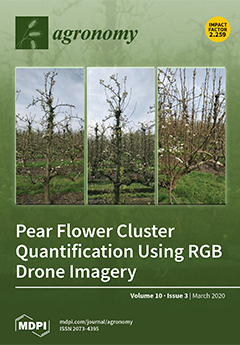Quinoa (
Chenopodium quinoa Willd.) yield potential needs to be further achieved by good management practices to meet the increasing global demand. Two years of orthogonal field experiments were undertaken to investigate the effects of irrigation onset criteria using soil matric potential (SMP) (−15, −25, and −55 kPa), nitrogen fertilizer rate (80, 160, and 240 kg ha
−1), and plant density (20, 30, and 40 plants m
−2) on quinoa growth, seed yield, weight, and protein content. Initiating irrigations at an SMP of −15 to −25 kPa achieved significantly (
p < 0.05) greater seed yield (37.2 g plant
−1), thousand kernel weight (2.25 g), and protein content (21.2%) than −55 kPa (25.2 g plant
−1, 2.08 g, and 19.8%, respectively). The 240 kg ha
−1 nitrogen rate had significantly (
p < 0.05) greater thousand kernel weight (2.26 g) and protein content (21.3%) than 80 (2.07 g and 19.5%, respectively) and 160 kg ha
−1 (2.14 g and 20.7%, respectively). The yield under 20 plants m
−2 reached 39.5 g plant
−1, which was 13.5 g plant
−1 higher than 40 plants m
−2 (
p < 0.05). The quinoa consumed most of the available nitrogen in the soil (410–860 kg ha
−1), indicating that quinoa should be part of a sound crop rotation program.
Full article





